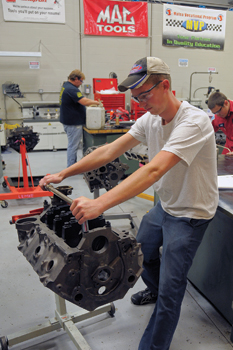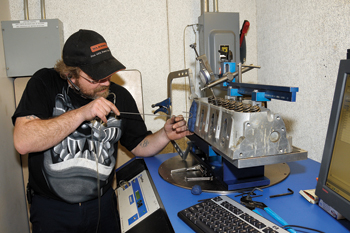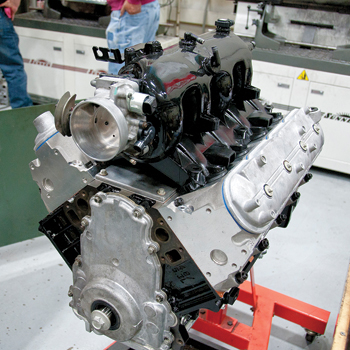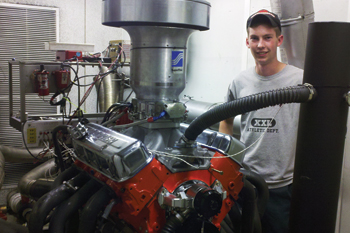chnicians in the industry, and provides a substantial advantage to its graduates in seeking employment, as well as the independent shops hiring them.
The High Performance program, which was developed by Professor Mike Garblic, covers a complete school year of three quarters. The professor of the course is Blaine Heeter (seen below), who has been assisted by Kevin Smith and Jim Butts.
Engine building, though, goes far beyond just the teaching hours at Sinclair as both Garblic and Heeter are involved with high-performance engines after hours.
Garblic, a longtime vintage drag vehicle fan, has been heavily involved in building of functional
replicas of two dragsters of former NHRA superstar Arnie Beswick, including a Pontiac Trans Am-based “Boss Bird” Funny Car.
Heeter serves as a crew chief for a local Ford drag team, tending to a 427-powered Falcon, along with a 408 cid Fairmont and an ’83 Mustang.
The prime purpose of this Heeter’s course involves the build-up (from scratch) of a high-performance powerplant.
There is no assigned engine type or model from the instructor; it is the choice of the student. It is also the responsibility of the student to provide all the parts and pieces for his particular build-up. The students explained that sometimes the parts cost up to $5,000-$6,000, but nobody’s complaining here. It’s definitely a once-in-a-lifetime opportunity!
Needless to say, the starting point for these build-ups is quite different. Some of the build-ups start off with new parts and pieces, while others show up with old, and sometimes rusty, junkyard parts.
It’s a laid-back atmosphere during the nine months of the build-up. And there is a close relationship with the instructors. Surprisingly, the age range of the students in a recent class varied between 19 and 65.
In this article, two of the engine build-ups will be discussed. Two more will follow in a later issue.
Engine Buildup #1
Kasey King, from Coshocton, OH, started the course when he was only 19. He came with experience though, having two years of automotive vocational training in high school.
Since his interest was performance engines, King took the opportunity of using a technical school to hone his skills. The starting point of his effort was a trashed 454 engine from a ’73 GMC pickup. The plan was to bore and stoke the block to 489 cubic inches with a capability of 500 horsepower. It took awhile, but the mission was accomplished — actually 528 horses and 500 ft.-lbs. of torque on the dyno. After tuning and refinement, he figures that 600 hp is possible.
Class Work Completed
That 454 GMC block was the main component used in the build-up, with most of the remainder being aftermarket parts and pieces.
King explained that he line-honed, de-burred, square-decked and did a 0.030 overbore, which added about 35 cubic inches. Finally, he balanced it at 850 rpm on a Sunnen crankshaft balancer.
The heads selected were 454 LS-6 versions, which also required work.
“I did some porting to take off some rough edges from the casting, which helped the air flow,” King said. “I also port-matched the gaskets between the intake manifold and head.” The compression ratio achieved was 10.5-1.
Also, the valves needed attention and King cleaned up the facings.
The gas-fuel mixture is provided by a monster 1100 cfm Demon four-barrel. The cam was initially planned to be a moderate flat-tappett, but he later decided on a more-aggressive mechanical roller type. The crank is aftermarket Eagle.
Coming from a drag racing family, it’s not surprising that the planned purpose of this engine. “I have a 1991 rail dragster that I run on a 1/8-mile strip,” King said. “I’m hoping I can get into the mid-fives with this engine powering it.”

Engine Build-Up #2
At 42 years of age, Dave Lemke (right)of Dayton, OH, describes himself as an “old school” mechanic. Lemke, who owns an auto repair and towing business in Michigan, said his new quest is to concentrate on his hobby and establish himself as a high-performance builder.
“With this build-up, I wanted to learn about upgrading the Chevy LS engines.”
To that end, he started with a used 140,000-mile 5.3L LS-1. The goal was to increase the horsepower to about 500 at the wheels. The engine’s final resting point will be in a 1981 Buick Regal.
 Class Work Completed
Class Work Completed
The block received the initial attention when it was shot-peened and measured. Next, it was punched out 0.125”, plus the addition of an aftermarket stroker cam provided an additional 61 cubic inches of displacement. That produced a 396 cid engine.
Lemke also wanted better engine oiling and cut channel on both the front and back of the block to open up a galley.
The next procedure was to balance the rotating mass of the engine that included the pistons, rods, pins and clips. Aftermarket parts were used internally with ADP Performance rods and moly pistons. Also, a GM LS7 cam was installed.
The stock intake was retained although it was ported and polished and was custom fabricated into a tunnel-ram configuration.
The heads received huge attention as Lemke figures he spent about 200 hours of machining on each of them. “I ground off everything that would hurt the flow. I then tested the heads on a Super Flow 1020 Bench and it recorded 278 cfm,” he said.
After the headwork was completed, the engine showed a huge increase in compression ratio from
initially at 9.5-to-1 to an impressive 12.2-1.
The injection system was acquired from an 8.1L Chevy Vortec engine, which produced an injection pressure of 42 lbs. compared to the 5.3’s 29 lbs. of pressure.
While both King and Lemke agree that their engine-building lesson at the community college is a once-in-a-lifetime experience, they are both hopeful that the lessons learned will provide them many engine-building opportunities and steady work in the future.


